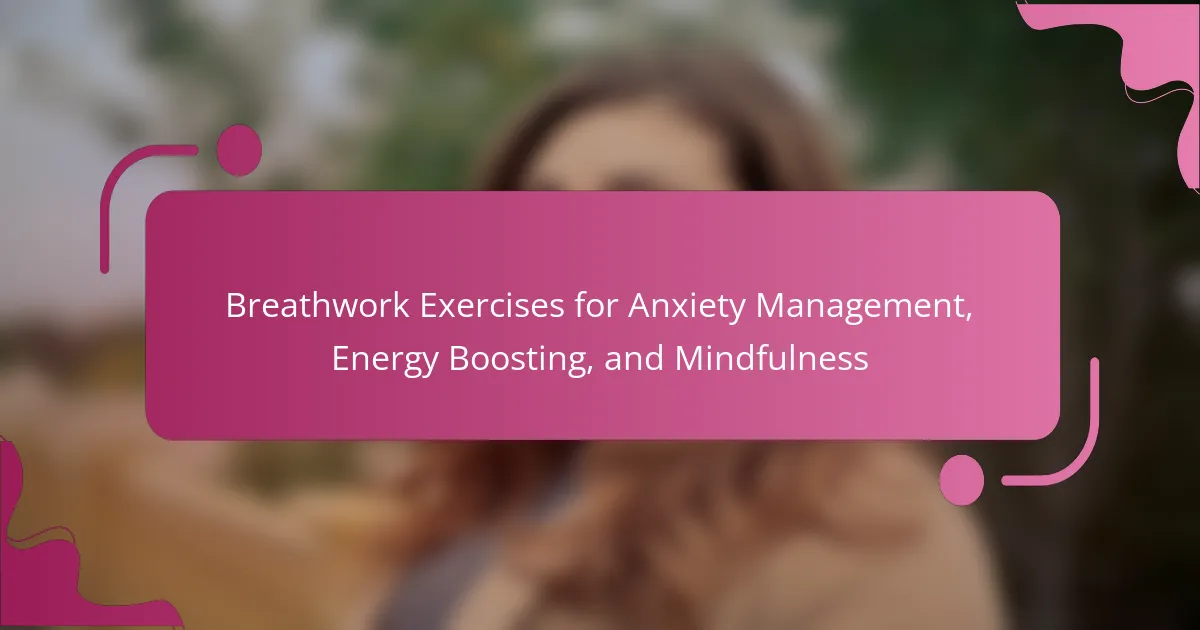Breathwork exercises provide effective strategies for managing anxiety, boosting energy, and enhancing mindfulness. These techniques promote relaxation, improve oxygen flow, and foster present-moment awareness. Regular practice can lead to lower stress levels, increased alertness, and improved emotional regulation. Various cultural approaches to breathwork offer unique methods to deepen the experience and benefits.
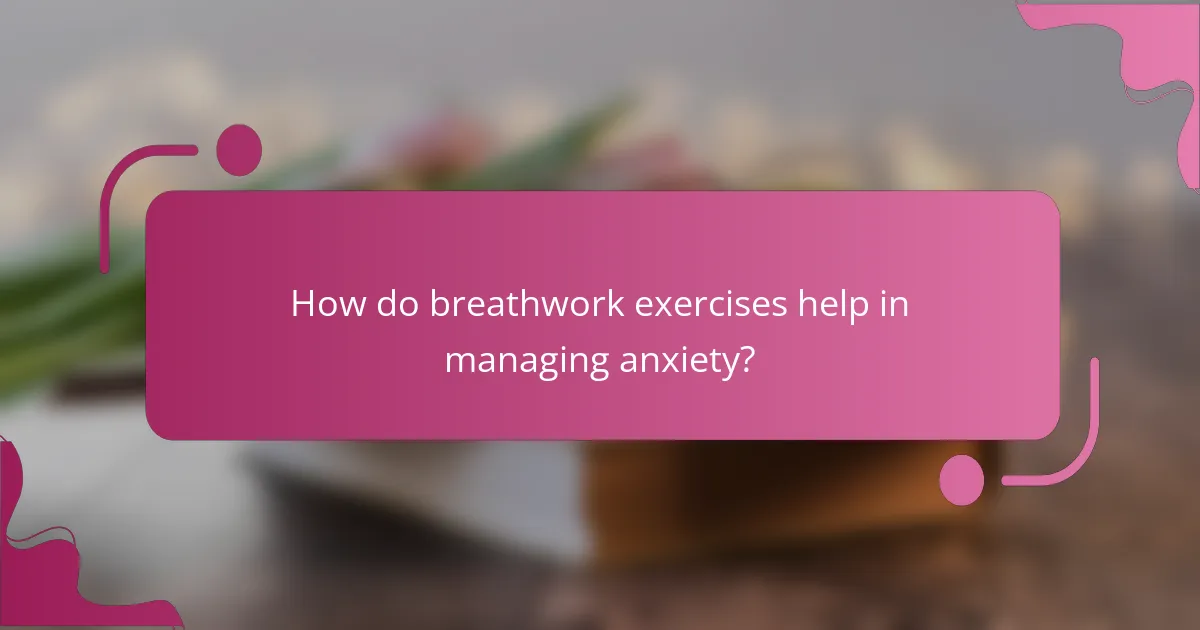
How do breathwork exercises help in managing anxiety?
Breathwork exercises effectively reduce anxiety by promoting relaxation and mindfulness. These techniques enhance oxygen flow, helping to calm the nervous system. Regular practice can lead to lower stress levels and improved emotional regulation. Studies show that breathwork can decrease cortisol levels, contributing to a sense of well-being.
What physiological changes occur during breathwork?
Breathwork induces various physiological changes that enhance mental and physical well-being. These changes include increased oxygen intake, reduced heart rate, and improved blood circulation.
During breathwork, the body shifts from a sympathetic state to a parasympathetic state, promoting relaxation. This transition helps lower cortisol levels, reducing anxiety and stress. Additionally, breathwork can stimulate the vagus nerve, which enhances emotional regulation and mindfulness.
Enhanced lung capacity is a unique attribute of regular breathwork practice. Studies show that consistent breathwork can increase lung function by up to 30%. This improvement contributes to better energy levels and overall vitality.
Breathwork also influences neurotransmitter levels. For instance, it can boost serotonin and endorphin production, which are essential for mood stabilization and emotional balance. These physiological transformations support anxiety management and mindfulness practices effectively.
Which specific breathwork techniques are most effective for anxiety?
Breathwork techniques such as diaphragmatic breathing, box breathing, and 4-7-8 breathing are effective for anxiety management. These methods promote relaxation and reduce stress levels. Diaphragmatic breathing engages the diaphragm, enhancing oxygen flow and calming the nervous system. Box breathing involves inhaling, holding, exhaling, and pausing for equal counts, which stabilizes breath and mind. The 4-7-8 technique combines inhalation for four seconds, holding for seven, and exhaling for eight, fostering tranquility and focus. Each technique can be practiced anywhere, making them accessible tools for anxiety relief.
How does breathwork compare to traditional anxiety treatments?
Breathwork offers an alternative approach to anxiety management compared to traditional treatments. It emphasizes mindfulness and regulates breath patterns, which can reduce anxiety symptoms effectively.
Traditional anxiety treatments often involve medication or therapy, focusing on chemical balance or cognitive restructuring. In contrast, breathwork exercises can be practiced independently, providing immediate benefits such as relaxation and energy boosting.
Breathwork promotes self-awareness and emotional regulation, which are crucial for long-term anxiety management. Studies indicate that breath-focused techniques can lower cortisol levels and enhance overall well-being.
While traditional treatments may take time to show results, breathwork can yield immediate effects, making it a valuable complement to conventional methods.
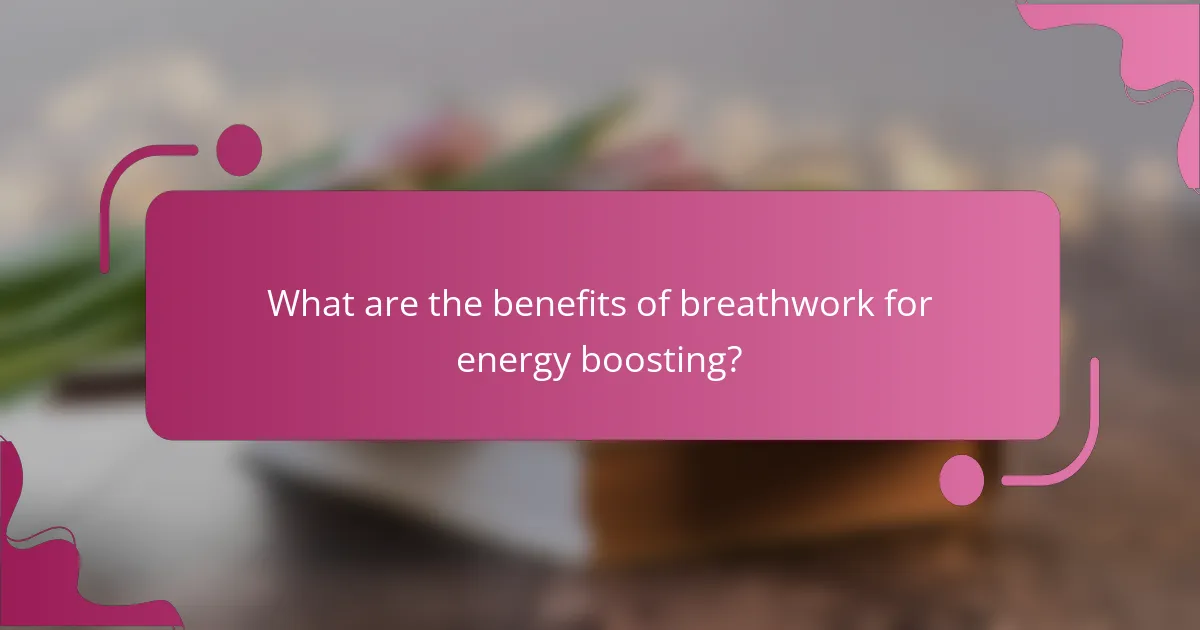
What are the benefits of breathwork for energy boosting?
Breathwork significantly boosts energy by enhancing oxygen flow and reducing stress. These exercises stimulate the nervous system, leading to increased alertness and vitality. For instance, deep diaphragmatic breathing can elevate energy levels by improving lung capacity and promoting relaxation. Studies show that regular breathwork practice can elevate mood and mental clarity, contributing to sustained energy throughout the day.
How can breathwork enhance physical performance?
Breathwork enhances physical performance by improving oxygen intake, reducing stress, and increasing focus. These exercises can lead to better endurance and quicker recovery times. Techniques like diaphragmatic breathing boost energy levels by optimizing lung capacity. Research shows that athletes who practice breathwork experience enhanced performance metrics, including increased stamina and reduced fatigue.
What is the role of breathwork in improving mental clarity?
Breathwork enhances mental clarity by promoting relaxation and focus. These exercises regulate breath patterns, reducing anxiety and increasing oxygen flow to the brain. As a result, individuals experience improved cognitive function and heightened awareness. Techniques such as diaphragmatic breathing and box breathing can specifically target mental fatigue, fostering a clearer mindset. Regular practice can lead to significant improvements in concentration and decision-making abilities.
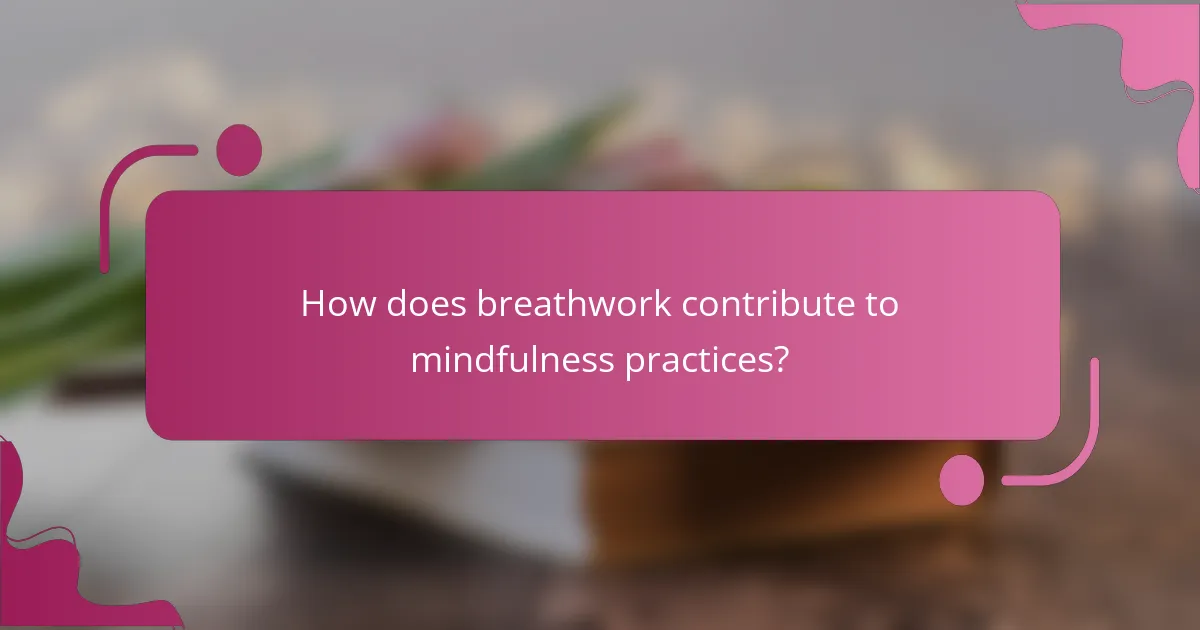
How does breathwork contribute to mindfulness practices?
Breathwork enhances mindfulness by promoting awareness and grounding in the present moment. This practice encourages deep, intentional breathing, which activates the parasympathetic nervous system, reducing anxiety and stress. Studies indicate that consistent breathwork can improve emotional regulation and increase overall mindfulness. Techniques such as diaphragmatic breathing and box breathing are effective in cultivating this awareness, allowing individuals to connect more deeply with their thoughts and feelings. As a result, breathwork serves as a powerful tool in mindfulness practices, fostering a sense of calm and clarity.
What techniques integrate breathwork into mindfulness meditation?
Breathwork techniques enhance mindfulness meditation by focusing on breath control to promote relaxation and awareness. Techniques include diaphragmatic breathing, box breathing, and alternate nostril breathing. Diaphragmatic breathing reduces anxiety by engaging the diaphragm, promoting deeper breaths. Box breathing, involving four equal phases of inhalation, retention, exhalation, and retention, boosts focus and energy. Alternate nostril breathing balances energy and calms the mind. Each technique integrates breathwork into mindfulness, improving emotional regulation and mental clarity.
How does breath awareness affect emotional regulation?
Breath awareness significantly enhances emotional regulation by promoting mindfulness and reducing anxiety. Breathwork exercises, such as diaphragmatic breathing, help activate the parasympathetic nervous system, leading to a state of calm. This practice allows individuals to observe their emotional responses without immediate judgment or reaction. As a result, breath awareness creates a buffer against stress, enabling better management of emotions. Regular practice can lead to improved emotional resilience over time.

What unique attributes distinguish breathwork practices across cultures?
Breathwork practices vary significantly across cultures, each offering unique attributes. For example, Tibetan Buddhist breathwork emphasizes spiritual enlightenment, while Pranayama in yoga focuses on energy control. Native American practices often incorporate nature, highlighting the connection to the earth. Additionally, some cultures utilize breathwork as a community bonding exercise, enhancing social cohesion. These distinctions reflect diverse philosophical beliefs and health approaches tied to each culture’s history and environment.
Which cultural traditions incorporate breathwork in their healing practices?
Various cultural traditions incorporate breathwork in their healing practices, including yoga, Buddhism, and Indigenous rituals. Yoga utilizes pranayama techniques for stress relief and mindfulness. Buddhism emphasizes breath awareness in meditation for emotional balance. Indigenous cultures often integrate breathwork with spiritual ceremonies to promote healing and connection. Each tradition highlights unique attributes of breathwork, enhancing its effectiveness in anxiety management and energy boosting.
How do regional variations influence breathwork techniques?
Regional variations significantly shape breathwork techniques by adapting practices to local cultures and environments. Different regions emphasize unique attributes, such as specific breathing patterns or intentions, that resonate with their communities. For instance, some cultures incorporate traditional music or rituals, enhancing the overall experience. Additionally, climate influences the choice of techniques; warmer climates may favor energizing practices, while cooler regions might focus on calming exercises. These adaptations ensure that breathwork remains relevant and effective across diverse settings, ultimately supporting anxiety management, energy boosting, and mindfulness.
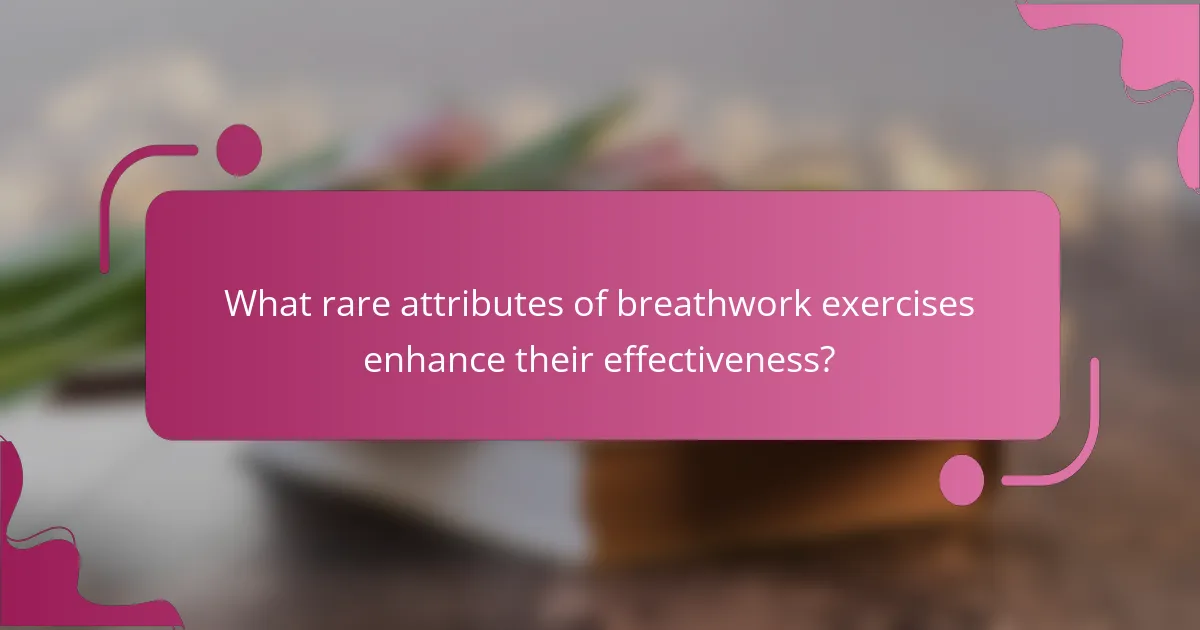
What rare attributes of breathwork exercises enhance their effectiveness?
Rare attributes of breathwork exercises include specific techniques that enhance focus and emotional release. These techniques, such as the use of rhythmic patterns or specific breathing ratios, can lead to deeper states of relaxation and heightened awareness. For instance, box breathing fosters a sense of control and reduces anxiety effectively. Additionally, integrating visualization during breathwork can amplify the emotional benefits, allowing practitioners to connect more profoundly with their intentions. These unique approaches contribute to the overall effectiveness of breathwork in managing anxiety and promoting mindfulness.
Which lesser-known breathwork methods yield significant benefits?
Lesser-known breathwork methods such as Buteyko, Holotropic, and Transformational Breath offer significant benefits for anxiety management, energy boosting, and mindfulness. Buteyko focuses on nasal breathing to reduce anxiety and improve oxygen efficiency. Holotropic Breathwork combines accelerated breathing with evocative music to facilitate emotional release and heightened awareness. Transformational Breath integrates sound, movement, and breath patterns to enhance emotional healing and self-discovery. Each method emphasizes unique attributes that contribute to mental clarity and stress reduction, making them valuable additions to traditional breathwork practices.
How can advanced breathwork techniques be safely practiced?
Advanced breathwork techniques can be safely practiced by following structured guidelines. Start with a calm environment to minimize distractions. Focus on specific techniques like diaphragmatic breathing or box breathing, which are effective for anxiety management.
Begin with shorter sessions, gradually increasing duration as comfort grows. Always listen to your body; if you feel lightheaded or anxious, pause and return to normal breathing. Incorporating mindfulness can enhance the experience, fostering a deeper connection to your breath.
Consider practicing with a certified instructor to ensure proper technique and safety. This adds an element of accountability and guidance, especially for beginners.
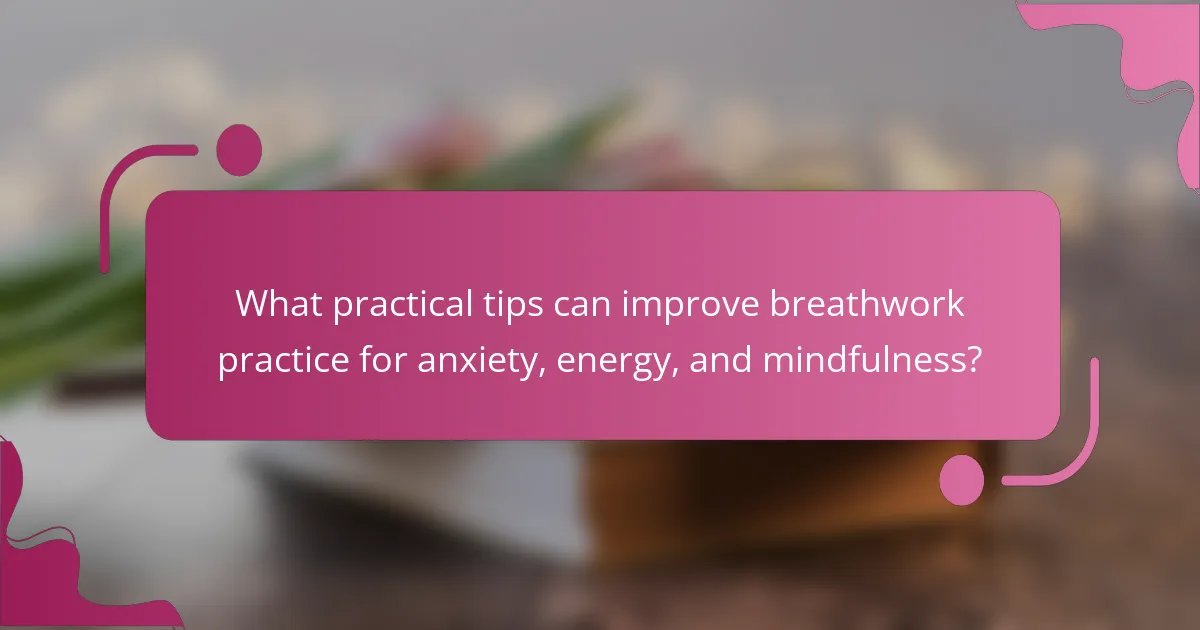
What practical tips can improve breathwork practice for anxiety, energy, and mindfulness?
Breathwork practice can be enhanced through structured techniques and mindful approaches. Focus on deep diaphragmatic breathing to calm anxiety. Incorporate energizing techniques like rapid inhalations to boost energy. Establish a consistent routine to foster mindfulness and enhance overall well-being. Consider guided sessions for better focus and understanding.
What common mistakes should be avoided in breathwork exercises?
Avoiding common mistakes in breathwork exercises enhances their effectiveness for anxiety management, energy boosting, and mindfulness. Key mistakes include neglecting proper posture, which can restrict breathing; overexerting oneself, leading to discomfort; and failing to establish a consistent practice, which diminishes benefits. Additionally, not paying attention to breath patterns may hinder the desired outcomes. Lastly, overlooking the importance of a calm environment can disrupt focus and reduce the practice’s effectiveness.
Which resources provide guidance for effective breathwork sessions?
Various resources provide guidance for effective breathwork sessions, including books, online courses, and workshops. Books like “The Healing Power of the Breath” offer structured techniques. Online platforms such as Udemy and Insight Timer provide courses tailored to anxiety management and mindfulness. Additionally, local wellness centers often host workshops led by experienced practitioners, enhancing the learning experience through direct interaction.
